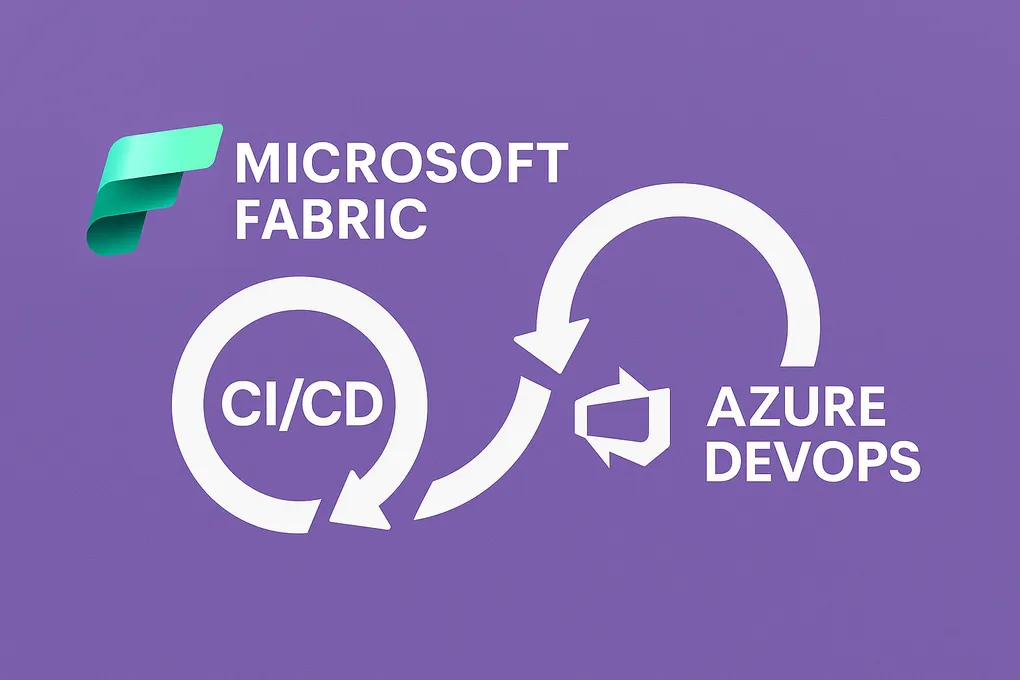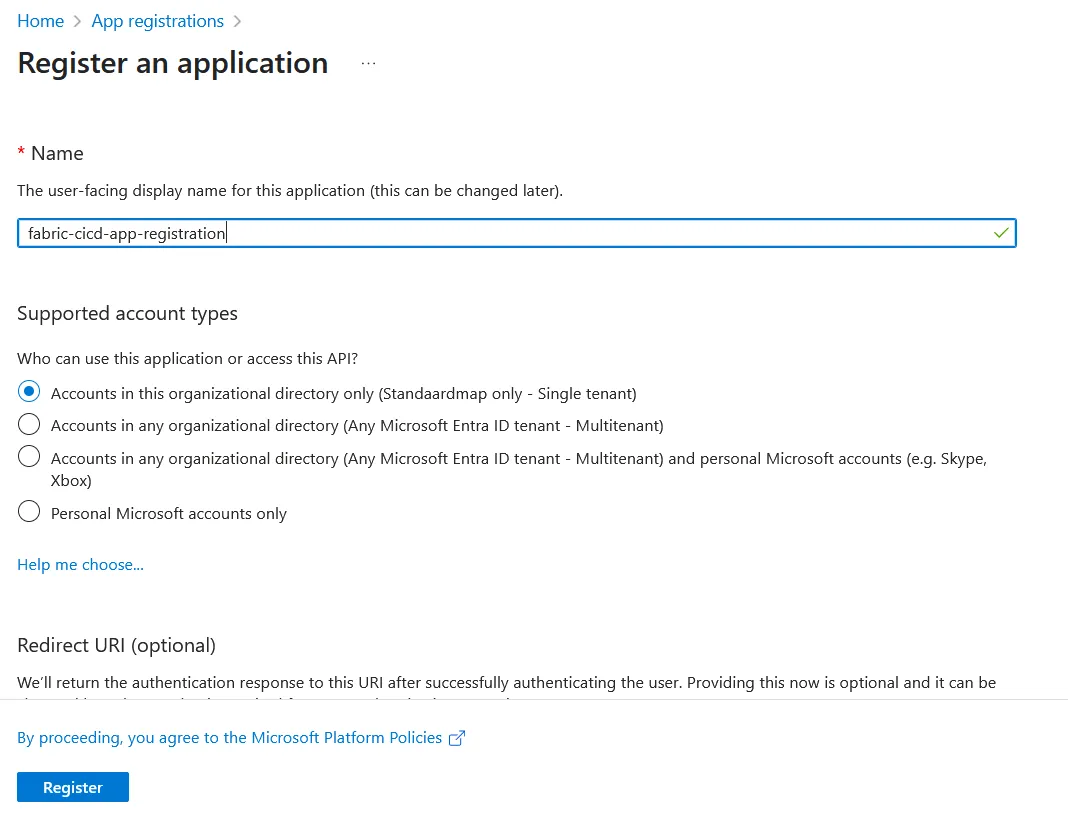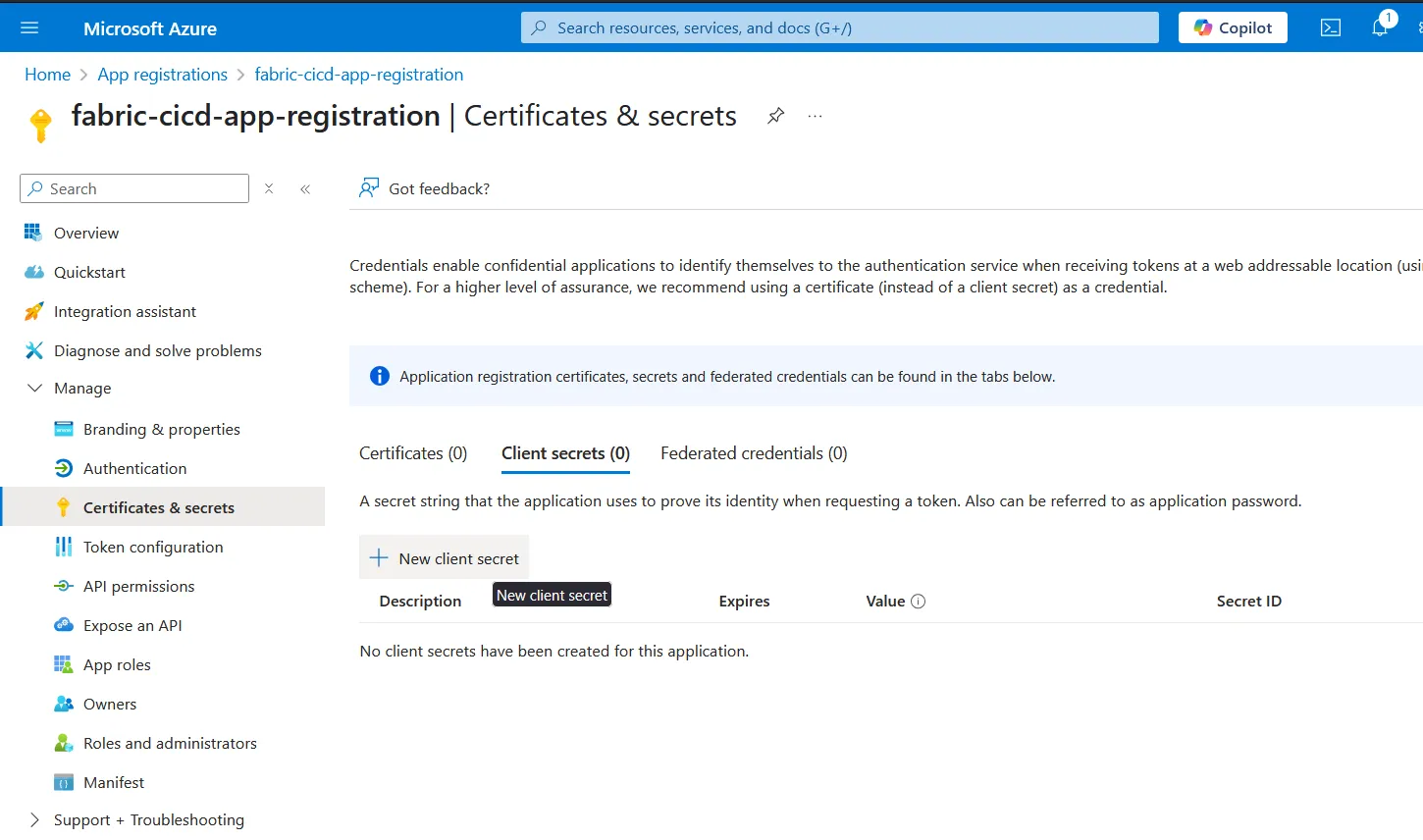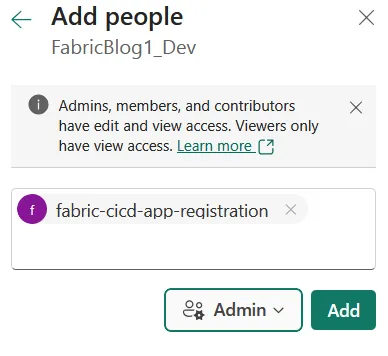
Deploying Python Wheels to Fabric Environments Using GitHub Actions or DevOps Pipelines
I’m currently working on a Microsoft Fabric solution that includes a custom Python library containing reusable code shared across our Notebooks. To manage deployments across our Development, Test, and Production environments, we’re using Microsoft’s fabric-cicd framework.
To ensure our development teams always use the latest version of the Python library in the Development environment, we decided to automate its deployment to a Microsoft Fabric Environment whenever a new version is pushed to our Git repository.
In this post, I’ll walk you through how we implemented this automation using GitHub Actions (or Azure DevOps), enabling fast, reliable updates across environments.
In This Post
In this post, we’ll walk through the key steps to implement an automated Python wheel deployment to a Microsoft Fabric environment:
- Register an application (Service Principal) in the Azure Portal
- Grant the Service Principal admin access to your Fabric workspace
- Create a Python script that uses the Fabric API to upload the
.whlfile - Set up a GitHub Action or Azure DevOps pipeline to automate the deployment
ℹ️ Note: All code in this blogpost can be found in my Github Repository
Register an Application (Service Principal) in the Azure Portal
The first step is to create an App Registration (Service Principal) in the Azure Portal. This Service Principal will allow our deployment pipeline to authenticate and access the Microsoft Fabric workspace.
To begin, open the Azure Portal and search for “App registrations”. Click “Create”, then enter the required details as shown below:

Once the app registration is created, you need to generate a client secret. Under Manage → Certificates & secrets, go to the Client secrets section and click “New client secret”:

Fill in the necessary details and create the secret. ⚠️ Important: Copy the client secret value and store it somewhere secure. It will not be visible again after you leave the page.
Grant the Service Principal access to your Fabric workspace
Next, we need to grant the Service Principal access to your Microsoft Fabric workspace. In this example, we’ll assign it admin rights at the workspace level to enable deployment permissions.
To do this:
- Navigate to your Fabric workspace.
- Click Manage access → Add people or groups.
- Search for the name of your Service Principal (the name you used during App Registration).
- Set the role to Admin and confirm to create the access rule.

Create a Python Script to Upload the .whl File Using the Fabric API
Next, we’ll create a Python script that authenticates using the Service Principal and uploads the built .whl file to the Microsoft Fabric environment.
In the following steps, I’ll walk you through each function required to complete the process. At the end, we’ll tie everything together into a single, runnable script.
✅ Import Required Modules
We start by importing the necessary Python modules. If any of these are not already installed in your environment, install them with:
pip install requests
pip install azure-identityℹ️ Note: To keep this post simple, we won’t use a package manager in this demo. However, I recommend using one to help manage your dependencies more effectively. Popular options include pip, poetry or uv.
Now import the modules:
import os
import time
import urllib.parse
from pathlib import Path
import requests
from azure.identity import ClientSecretCredential🔐 Get an Authentication Token
Next, we retrieve an access token using the Service Principal we created earlier. This token will be passed to the Fabric API to authorize the upload.
🚫 Note: Do not hard-code your credentials. You’ll pass the
client_id,client_secret, andtenant_idlater from GitHub Actions or Azure DevOps pipelines using environment variables or secrets.
We use the ClientSecretCredential class from the azure-identity library:
def _get_fabric_api_token(client_id: str, client_secret: str, tenant_id: str) -> str:
token_credential = ClientSecretCredential(
tenant_id=tenant_id,
client_id=client_id,
client_secret=client_secret
)
token = token_credential.get_token("https://api.fabric.microsoft.com/.default")
return token.token🧩 Fabric API Requests
Next, we need a way to make API requests to the Microsoft Fabric API. To keep our code clean and reusable, we’ll build a single, generic method for making authenticated HTTP requests.
def _fabric_api_request(request_type: str, token: str, request_url: str, files: dict | None = None, headers: dict | None = None, max_retries: int = 3) -> str:
if headers is None:
headers = {
"Content-Type": "application/json",
}
headers["Authorization"] = f"Bearer {token}"
request_url = f"https://api.fabric.microsoft.com/v1/{request_url.lstrip('/')}"
for attempt in range(1, max_retries + 1):
response = requests.request(
request_type,
request_url,
headers=headers,
files=files,
)
if response.status_code == 200:
return response.json()
if attempt < max_retries:
time.sleep(3)
else:
msg = f"Fabric API request failed after {max_retries} attempts with status code {response.status_code}: {response.text}. URL: {request_url}"
raise Exception(msg)
return None📥 Getting Fabric Environment Information
Before deploying the .whl file, we need to retrieve the current state of the target Fabric environment. This state indicates whether the environment is in a published (ready) state or if a previous deployment is still in progress.
If a deployment is currently running, we have the option to cancel it before proceeding with the new deployment. This ensures that we don’t run into conflicts or overlapping operations.
def _get_fabric_environment_state(token: str, workspace_id: str, environment_id: str) -> str:
environment_details = _fabric_api_request(
"GET", token, f"workspaces/{workspace_id}/environments/{environment_id}")
try:
return environment_details["properties"]["publishDetails"]["state"]
except KeyError as e:
msg = f"Incorrect API response {environment_details}"
raise Exception(
msg) from e
def _cancel_fabric_environment_publish(token: str, workspace_id: str, environment_id: str) -> None:
_fabric_api_request("POST", token,
f"workspaces/{workspace_id}/environments/{environment_id}/staging/cancelPublish")🔍 Retrieve Existing Custom Libraries
Before deploying a new .whl file, we first check which custom libraries are currently deployed in the Fabric environment. This allows us to detect and clean up any older versions of the same library.
The following function retrieves the list of currently deployed wheel files. If the environment is empty or unavailable, we safely return an empty structure:
def _get_fabric_environment_custom_libraries(token: str, workspace_id: str, environment_id: str) -> dict:
try:
return _fabric_api_request("GET", token, f"workspaces/{workspace_id}/environments/{environment_id}/staging/libraries")
except Exception:
return {"customLibraries": {"wheelFiles": []}}🧹 Delete Older Versions of the Custom .whl Library
To avoid version conflicts or clutter, we delete any previously deployed versions of the same wheel file. The logic below checks all deployed libraries, and if any file starts with the name of our package, it will be removed.
def _delete_fabric_environment_custom_library(token: str, workspace_id: str, environment_id: str, library_name: str) -> dict:
encoded_library_name = urllib.parse.quote(library_name)
return _fabric_api_request("DELETE", token,
f"workspaces/{workspace_id}/environments/{environment_id}/staging/libraries?libraryToDelete={encoded_library_name}"
)
def _delete_fabric_environment_published_custom_libraries(token: str, workspace_id: str, environment_id: str, package_name: str) -> None:
libraries = _get_fabric_environment_custom_libraries(
token, workspace_id, environment_id)
if "customLibraries" in libraries and "wheelFiles" in libraries["customLibraries"]:
for library_name in libraries["customLibraries"]['wheelFiles']:
if library_name.startswith(package_name):
print(
f"Deleting custom library {library_name} from environment {environment_id}")
# Delete the custom library
_delete_fabric_environment_custom_library(
token, workspace_id, environment_id, library_name)🚀 Upload the New .whl File and Start the Publish
Once the environment is ready and any previous versions of the library have been cleaned up, we can upload the new .whl file and initiate the publish process.
The first function uploads the wheel file to the Fabric environment’s staging area. The second function starts the publish process, which promotes the changes to the environment.
def _upload_fabric_environment_custom_library(token: str, workspace_id: str, environment_id: str, file_path: str) -> None:
file = Path(file_path)
files = {'file': (Path(file_path).name, file.open('rb'))}
_fabric_api_request("POST", token,
f"workspaces/{workspace_id}/environments/{environment_id}/staging/libraries",
files=files,
headers={}
)
def _publish_fabric_environment(token: str, workspace_id: str, environment_id: str) -> None:
_fabric_api_request("POST", token,
f"workspaces/{workspace_id}/environments/{environment_id}/staging/publish"
)
print(
f"Environment {environment_id} publish started successfully. Waiting for it to finish...")⏳ Wait Until the Fabric Environment Publish Completes
Publishing changes to a Fabric Environment can take a significant amount of time — in some cases, up to 25–30 minutes. To handle this gracefully, we include logic to poll the deployment status every 30 seconds until it completes or a timeout is reached.
This ensures that our deployment process doesn’t proceed prematurely while the environment is still updating. It also provides a clean way to detect and respond to failed or cancelled deployments.
def _is_fabric_environment_published(token: str, workspace_id: str, environment_id: str, allow_cancelled: bool = False) -> bool:
state = _get_fabric_environment_state(token, workspace_id, environment_id)
if state == "Success":
return True
if state == "Failed" or (not allow_cancelled and state == "Cancelled"):
msg = f"Environment {environment_id} failed to publish with state: {state}"
raise Exception(
msg
)
return False # Else, the environment is not published yet
def _wait_until_fabric_environment_publish_finished(token: str, workspace_id: str, environment_id: str, allow_cancelled: bool = False, timeout_in_minutes: int = 40) -> bool:
start_time = time.time()
while True:
if _is_fabric_environment_published(token, workspace_id, environment_id, allow_cancelled):
print(f"Environment {environment_id} is published successfully.")
return True
if time.time() - start_time > timeout_in_minutes * 60:
msg = f"Timeout reached while waiting for environment {environment_id} to be published"
raise TimeoutError(
msg
)
print("Waiting for environment to be published, checking again in 30 seconds...")
time.sleep(30) # Wait 30 seconds before checking again🧩 Putting It All Together
Finally, we tie all the pieces together into a single script entry point. This block ensures that the full deployment process runs end-to-end.
At this stage, we retrieve the required environment variables for authentication and deployment:
- Fabric Workspace ID
- Fabric Environment ID
- Tenant ID
- Client ID
- Client Secret
- File path to the
.whlfile
These values will be passed into the script via environment variables from your DevOps pipeline or GitHub Actions workflow.
def run_wheel_deployment_to_fabric(token: str, workspace_id: str, environment_id: str, file_path: str) -> None:
try:
# First, check if the environment is in published state
if _get_fabric_environment_state(token, workspace_id, environment_id) != "Success":
print("Cancelling earlier publish....")
_cancel_fabric_environment_publish(
token, workspace_id, environment_id)
_wait_until_fabric_environment_publish_finished(
token, workspace_id, environment_id, allow_cancelled=True)
# We need to delete the custom libraries already in the environment
package_name = Path(file_path).name.split('-')[0]
_delete_fabric_environment_published_custom_libraries(
token, workspace_id, environment_id, package_name)
_upload_fabric_environment_custom_library(
token, workspace_id, environment_id, file_path)
_publish_fabric_environment(token, workspace_id, environment_id)
_wait_until_fabric_environment_publish_finished(
token, workspace_id, environment_id)
print(
f"Deployment of {file_path} to environment {environment_id} completed successfully.")
except Exception as e:
print(f"An error occurred during deployment: {e}")
raise e
if __name__ == "__main__":
CLIENT_ID = os.getenv("FABRIC_CLIENT_ID")
CLIENT_SECRET = os.getenv("FABRIC_CLIENT_SECRET")
TENANT_ID = os.getenv("FABRIC_TENANT_ID")
WORKSPACE_ID = os.getenv("FABRIC_WORKSPACE_ID")
ENVIRONMENT_ID = os.getenv("FABRIC_ENVIRONMENT_ID")
FILE_PATH = os.getenv("FABRIC_FILE_PATH")
if not all([CLIENT_ID, CLIENT_SECRET, TENANT_ID, WORKSPACE_ID, ENVIRONMENT_ID, FILE_PATH]):
error_message = "One or more environment variables are not set."
raise ValueError(error_message)
token = _get_fabric_api_token(CLIENT_ID, CLIENT_SECRET, TENANT_ID)
run_wheel_deployment_to_fabric(
token, WORKSPACE_ID, ENVIRONMENT_ID, FILE_PATH)🚀 GitHub Action Integration
Now that we’ve built the deployment script, we can run it from a GitHub Action (or an Azure DevOps pipeline). In this blog post, we’ll focus on using GitHub Actions, but if you’re using Azure DevOps, you can find the corresponding pipeline example in my GitHub repository.
🔐 Define Required Secrets
First, we need to configure the required credentials and environment-specific variables. In GitHub, go to your repository settings:
Settings → Security → Secrets and Variables → Actions
Create the following repository secrets:
FABRIC_CLIENT_ID: The client ID of your previously created Service PrincipalFABRIC_TENANT_ID: The tenant (directory) ID of your Azure AD instanceFABRIC_CLIENT_SECRET: The secret value you stored when creating the Service PrincipalFABRIC_WORKSPACE_ID: The ID of the Fabric Workspace containing your environment (see note below)FABRIC_ENVIRONMENT_ID: The ID of the Fabric Environment you want to deploy to (see note below)
ℹ️ Note:
You can find the Workspace ID and Environment ID directly in the URL when viewing the Fabric Environment in your browser.
The URL typically looks like:
https://app.powerbi.com/groups/<workspace_id>/sparkenvironments/<environment_id>?experience=power-bi
Copy the values for<workspace_id>and<environment_id>and use them in your GitHub secrets.
Next up, create an GitHub Action, and use the following code. This code will use Python’s build module to build a new wheels file based on the python in the same repository.
🛠️ Create the GitHub Action Workflow
Next, create a GitHub Action workflow that automates the build and deployment of your Python wheel file to Microsoft Fabric.
The following workflow uses Python’s build module to generate a .whl file from your repository source code. It then finds the built file and triggers your deployment script.
Save this file as .github/workflows/deploy.yml in your repository:
name: Deploy Wheels to Fabric
on:
push:
branches:
- main
jobs:
deploy:
runs-on: ubuntu-latest
steps:
- name: Checkout repository
uses: actions/checkout@v4
- name: Set up Python 3.11
uses: actions/setup-python@v5
with:
python-version: '3.11'
- name: Install build and clean dist
run: |
python -m pip install --upgrade pip
python -m pip install build
python -m pip install requests
python -m pip install azure-identity
rm -rf ./dist
- name: Build wheel
run: |
python -m build
- name: Find wheel file
id: find_wheel
run: |
WHEEL_FILE=$(find $(pwd)/dist -name "*.whl" -print -quit)
echo "WHEEL_FILE=$WHEEL_FILE" >> $GITHUB_ENV
echo "Wheel file path: $WHEEL_FILE"
- name: Deploy wheel to Fabric
env:
FABRIC_TENANT_ID: ${{ secrets.FABRIC_TENANT_ID }}
FABRIC_CLIENT_ID: ${{ secrets.FABRIC_CLIENT_ID }}
FABRIC_CLIENT_SECRET: ${{ secrets.FABRIC_CLIENT_SECRET }}
FABRIC_ENVIRONMENT_ID: ${{ secrets.FABRIC_ENVIRONMENT_ID }}
FABRIC_WORKSPACE_ID: ${{ secrets.FABRIC_WORKSPACE_ID }}
FABRIC_FILE_PATH: ${{ env.WHEEL_FILE }}
PYTHONUNBUFFERED: '1'
run: |
python devops_pipelines/deploy_wheels_file_to_fabric.pyThis action is triggered on every push to the main branch. It builds the wheel file, locates it, and uses your deployment script to upload and publish it to the configured Fabric Environment.
✅ Conclusion
And there you have it! With this setup, every new commit or pull request to the main branch will automatically trigger your pipeline, build a new wheel file, and deploy it to your Microsoft Fabric environment.
If you found this helpful, feel free to leave a comment below. If you run into any issues or have questions, you’re welcome to reach out in the comments or connect with me on LinkedIn for further assistance.